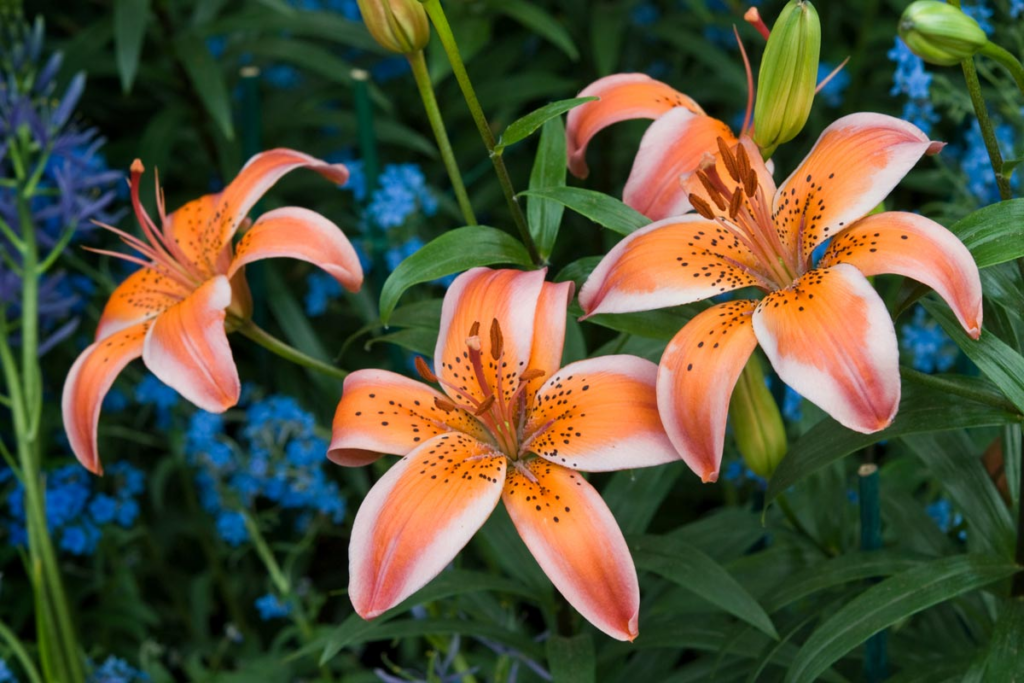Rose Lily Flower Types, Images, and Care Tips
The name “lily” means “whiteness,” yet the flowers come in a variety of colors and shapes. You may be thinking, what am I talking about? It’s Rose Lily! Yes, that is correct, but I am surprised about these beautiful and fragrant flowers and their surprising varieties.
Today, I am here to introduce you to one of the new things that can do wonders in your garden. Isn’t this interesting? To grow some purest white to the deepest garnet, all colors of pink, yellow, and orange are represented. So what are you waiting for? Let’s begin to learn about the different types of Rose Lily flowers.
Key takeaways:
- The other types of roselilies are Asiatic lilies, Oriental Lilies, Trumpet lilies, Orienpet lilies, Hybrid lilies from Los Angeles, etc.
- You need to water frequently for proper care.
Plant hunters picked up and took back new and exotic lily species from America, Asia, and Japan as Europeans began to explore far-flung places. What image would you conjure up in your mind if someone asked you to imagine a lily?
It’s probably a massive, pure white trumpet-shaped bloom with large stamens packed with blemish flowers. Let us know more about the rose lily, its types, and more importantly its care tips.
Let’s get started.
About Rose lily
The Lilies have traditionally flourished in the wild over North America, Europe, and Asia, and as societies advanced, mankind has begun to appreciate and produce these lovely blooms. With rose lilies, there are many types of lilies a garden likes to grow like the Rubrum Lily, Watsonia Bugle,
Before proceeding is it, it is important to know about the rose lily. First, it is one of the fantabulous lilies that is grown by every farmer in his home garden but why so why are you so fascinated by the lilies?
Rose lily tends to produce a double-flowered pollen-free lily that consists of various petals. Its flowers produce an aromatic scent in the plant, not as strong as the Oriental lilies.
It is a cross between the trumpet lilies and the Oriental lilies. Its flowers come in large shapes that bloom in various colors ranging from pink white etc.
Various farmers adore it because of its fragrance which attracts everyone towards it. They are the popular cut flowers grown in every garden as an ornamental plant. Its beauty is unmatchable.
Types of Rose Lilies
There are eight types of rose lilies which are mentioned below:
Asiatic lilies-
Asiatic hybrids are a cross between several different lily species. Each stalk has 3 to 6 flowers, and the petals are frequently speckled. They are available in a variety of colors, including orange, red, yellow, and creamy white.
Oriental Lilies-
Oriental lilies are among the most fragrant of all the lilies. The blooms’ intoxicating perfume is especially intense in the evening. Oriental lilies have larger leaves than some other lily kinds, and their foliage and blossoms are durable to deer and rabbits. Oriental lilies produce a lot of heavy pollen in their anthers.

Trumpet lilies:
These are a type of lily that blooms in the spring. Their petals are spotless, and their leaves are large, though not as broad as an Oriental lily’s leaves. Trumpet lilies are available in a variety of colors, including white, yellow, orange, cream, and pink, with a star-shaped throat in different colors.

Orienpet lilies:
Orienpet lilies are a cross of Oriental hybrids and trumpet lilies and are one of the greatest varieties of lilies for summertime gardening. Without completely opening into a large bloom, their blossoms have a shallow trumpet shape.

Hybrid lilies from Los Angeles:
LA hybrids are the showgirl cousins of plain Asiatic lilies, resulting from a genetic cross between Asiatic and “Easter-type” lilies. There is no scent to these.

Turk’s Cap lilies:
These are a type of lily that grows in the Turks. These are easily identified by their beveled edge blooms. Turk’s cap daisies are as cute as they come, with tiny butterflies dangling from the ends of graceful stems.

Lilies of Canada:
The Canada lily is a natural North American lily with orange or yellow petals that are gently recurved. Every stem produces whorls of 3 to 8 leaves at intervals along the length of the stem, and the flowers develop to reach between 2 and 4 feet tall.

Lilies of the genus Longiflorium:
Longiflorium lilies, sometimes known as Easter lilies, are all but solely marketed as seasonal plants.

How do you plant Lilies/Rose Lily flower plants?
Do you know how to plant the lilies? If yes, then it’s good. But if you are not aware of its planting process, then have a glimpse at the following points:
- To a depth of 12 to 15 inches, increase the soil.
- Plant the bulbs three times as deep as the bulb’s diameter and the sharp side on top of the trench. Deep planting promotes the developing stem to send out roots, which can assist in stabilizing the plant and reducing the necessity of propping. Thorough planting also keeps lily bulbs cool when the weather is hot other plants that can grow in the driest weather conditions are agave, coneflower, desert rose, harebell, ice plant, etc.
- Fill the hole with soil and lightly push it down.
- Three times the length of the bulb should be the spacing between bulbs (usually about 8 to 18 inches apart, depending on the variety).
- Plant lilies in groupings of three to five bulbs for added aesthetic value.
- When you’re ready to plant, make sure you give it plenty of water.

How to take Care of lilies?
Planting lilies is a good thing but taking care of them is another thing that one needs to maintain. Follow the below care tips for rose lilies:
- Water frequently throughout active development, especially if rainfall is less than 1 inch per week.
- Lilies should be mulched to maintain their roots temperately. The compost should be moist but not wet to the touch.
- From seeding to 6 weeks after flowering, apply a high-potassium liquid fertilizer every 2 weeks.
- In the spring, form a layer coating of compost followed by a 2-inch layer of mulch.
- Big lilies should be staked.
- Lilies only bloom once every season, but you can pluck the faded blooms to save the plants from wasting energy on seed production.
- You can even remove just the stem after the lily blossoms. Nevertheless, wait till the petals have withered down and turned brown in the autumn before removing them.
- In the late fall or early spring, chop down the waste stems.
- Add 4 to 6 inches of mulch before winter to prevent the ground from freezing and allow the stems to continue to grow. Once the final hard frost has passed, put the mulch away until springtime.
- If you don’t have snowfall in your area, keep the soil moist during the winter.
- Whenever the lily stems break through the mulch in the spring, gradually eliminate them.
- As fresh growth develops in the spring, divide plants every 3 to 4 years. Simply lift and divide the clumps of plants. Add additional fertilizer to the new bulbs before replanting them.
How to Plant Rose Lily (Few Tips)?
Below are the tips to follow for planting a Rose lily in the home garden. Follow them to understand them in a better way. They are as follows:
- At first, you are required to loosen the soil about 12 to 15 inches deep.
- After that, you can plant the lilies more than the depth of the bulbs.
- Because it will help in encouraging the growth of the roots.
- Then you have to keep the bulb in that hole.
- By filling the hole gently with the soil you have to dampen it.
- You have to provide every bulb with a space of equal distance about 8 to 18 inches apart from each other depending on the variety you are growing in the garden.
- For better results, you can plant them in groups of 3-5 if there is much space in the area.
- After planting, we have to water them fully so that the plant grows well and you can enjoy the benefits of the lilies.
Conclusion
In this article, you understand the varieties of rose lilies and a few other varieties of lilies. Rose lily tends to produce a double-flowered pollen-free lily that consists of various petals. Its flowers produce an aromatic scent in the plant, not as strong as the Oriental lilies.
It is a cross between the trumpet lilies and the Oriental lilies. Its flowers come in large shapes that bloom in various colors ranging from pink white etc. You come to know how to plant them and even how to take care of them. I hope this article will be helpful for you all. Read the article carefully for deeper knowledge.
Thanks for reading! Happy Gardening!


